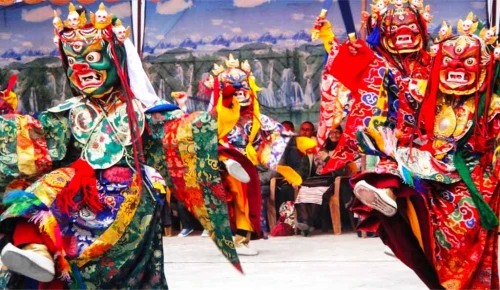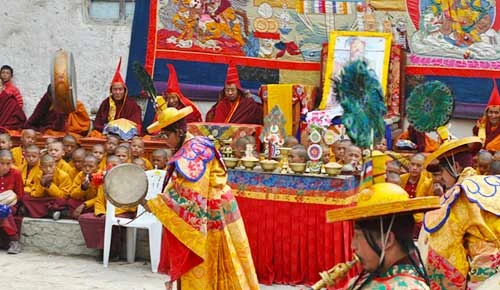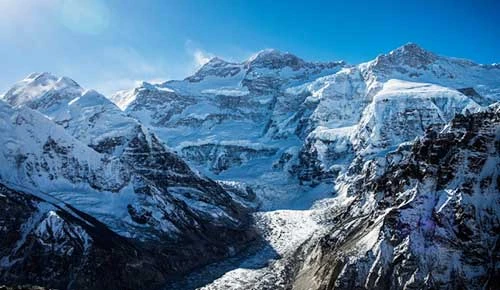Mount Kailash: Complete Guide to the Sacred Peak of the Himalayas
Majestically rising in isolation in the wilderness of the western Tibetan plateau, Mount Kailash is acknowledged as one of the most revered, yet mysterious, peaks in the world. Mount Kailash, at an elevation of 6,638 meters (21,778 feet), is undeniably the tallest snow-clad mountain with a stunning view of symmetry, although it is not among the highest in the Himalayas, and it enjoys immense spiritual significance. Referred to by numerous ancient texts as the "Center of the Universe," Mount Kailash has held the imagination of pilgrims, trekkers, and mystics for several millennia.
Mount Kailash is unique not just because of its majestic appearance but also due to its religious significance. It is considered a holy site by the four major religions—Hinduism, Buddhism, Jainism, and Bon—with divine presence attributed to this lone-standing mountain by each of these religions and their myths. It is considered by Hindus to be the abode of Lord Shiva and his consort Parvati, divine beings, and a seat of eternal peace and power. It is the home of Demchok (Chakrasamvara), the wrathful deity symbolizing supreme bliss, according to Buddhists. Jains regard it as the site where the first Tirthankara, Rishabhdev, attained nirvana. For the Bon, Kailash is the seat of all spiritual power.

Like the many myths surrounding the mountain, the fact that no human has yet set foot on Mount Kailash adds to its mystique. While various choices of peaks in the world have been conquered, the height of Kailash is either voluntarily left alone or by the refusal of permission to climb out of respect for its sacredness. Thus, the untaken ascent stands symbolic of spiritual transcendence, beyond reach, and pure.
The journey to Mount Kailash is more than just trekking; it is one of spiritual transformation. Every year, thousands of pilgrims from India, Nepal, and other parts of the world undertake the tough yet rewarding Kailash Mansarovar Yatra, which crosses under severe landscape and high passes down to the ritual form of circumambulation around Mount Kailash, known as Kora.
In this all-inclusive guide, we shall cover every aspect of Mount Kailash—its spiritual background, geographic description, routes of travel, trekking tips, and practical advice. This blog will be of enormous assistance to you if you are planning a pilgrimage or are simply curious about this sacred Himalayan legend.
Table of Contents
Where is Mount Kailash Located?
Mount Kailash, generally considered the most sacred peak in the world, is located in the remote southwestern corner of the Tibet Autonomous Region of China, close to the borders of India, Nepal, and Bhutan. It lies in Ngari Prefecture, in Burang County, in what is treated as the greater Trans-Himalayan mountain range.
This iconic mountain rises to an elevation of 6638 meters (21,778 ft.), and in spite of its relatively small stature compared to other giants of the Himalayas, Mount Kailash has unmatched spiritual values. It scores well on both geographical prominence and spiritual significance.
Coordinates of the Mountain and Its Surrounding Areas:
- Latitude: 31.0675° N
- Longitude: 81.3119° E
Mount Kailash is to the north of two important and sacred lakes:
- Lake Mansarovar (Mapam Yumco): A freshwater lake about 20 km southeast of Kailash, Mansarovar is said to be one of the highest freshwater lakes and has profound religious significance for the peoples of Tibet, Nepal, and India.
- Lake Rakshastal: Located near Mansarovar, this salt lake holds mythological and mystical significance.
Neighboring Countries Accessibility:
- Nepal: Stand atop Mount Kailash while approaching by way of either the Simikot-Hilsa route or the Lhasa route via Kathmandu.
- India: It lies near the Indian border states of Uttarakhand and Sikkim; however, usually, Indian pilgrims access it across Nepal or via lipulekh Pass.
- Tibet (China): Since Mount Kailash falls within China's administrative boundaries, foreign travelers are required to get Tibet Travel Permits and enter the region only as part of organized group tours by registered agencies.
Cultural and Geographical Importance of the Region:
People often refer to the area surrounding Mount Kailash as "The Roof of the World," a region marked by rugged landscapes, arid plateaus, and snow-capped peaks. This is a lonesome environment: one that looks stunning but appeals to thousands of spiritual seekers and adventurers every year. For several religions, including Hinduism, Buddhism, Jainism, and Bon, the mountain serves as both a geographical phenomenon and a cosmic center on earth.
Religious and Spiritual Significance of Mount Kailash
There is more to Mount Kailash than just beauty, for the pitiful representation of power worshipped with equal intensity by the four major religions-Hinduism, Buddhism, Jainism, and Bon. It has become somewhat of a paradox spanning geographical boundaries, drawing thousands of pilgrims every year to witness and pay homage to this mystical mountain.

In Hinduism: The Abode of Lord Shiva
Hindus truly consider Mount Kailash to be the divine residence of Lord Shiva and call it Shiva's abode, where Shiva and Parvati meditate in eternal bliss. Hindu scriptures presuppose that this mountain is considered Meru Parvat or the cosmic axis, the center of the universe. People embark on the pilgrimage of Kailash Parikrama (Kora) to gain blessings for themselves, wash away sins, and achieve moksha.
In Buddhism: The Home of Demchok (Chakrasamvara)
Like the wrathful embodiment of the Buddha representing supreme bliss, Tibetan Buddhism holds Mount Kailash to be the residence of Demchok (Chakrasamvara). The mountain is also famously linked with Milarepa, the great Tibetan yogi, who is known to have defeated Naro Bon-chung, the Bon master, in a spiritual duel on Kailash that established the supremacy of Buddhism in the region. It is said that circumambulating Mount Kailash clockwise is one of the most powerful acts of worship and purification ever.
Jainism Site of First Tirthankara’s Liberation
Jains believe that Rishabhdev (Adinath), the first Tirthankara and founder of Jainism, attained moksha (liberation) at Mount Kailash, which they call Ashtapada. The Jains hold that a visit to this towering sacred monument is a major spiritual aspiration, although it is restricted from access for reasons that are geographic and political.
In Bon: The Nine-Story Swastika Mountain
The Bon is an ancient pre-Buddhist religion of Tibet that considers Mount Kailash as a sacred spiritual pillar—the Nine-Story Swastika Mountain—and axis mundi or world center. Bon followers differ from the Buddhists and Hindus in the way that they perform Kora counterclockwise to honor their tradition and teachings of the ancestors.
Mount Kailash Kora (Parikrama)
The Mount Kailash Kora is the sacred circumambulation around the base of Mount Kailash, cherished by Hindus, Buddhists, Jains, and Bon followers. The kora is about 52 kilometers long; it is believed that along the course of the kora, a pilgrim's sins are washed away and he is granted blessings. Generally, a pilgrim takes about three days to finish the Kora, passing through significant points such as Dirapuk, the high-altitude Dolma La Pass (5,630m), and Zutulpuk Monastery. While physically grueling, the spiritual transformation that pilgrims undergo attracts thousands every year to the Kailash Mansarovar Yatra. For a detailed guide on route, altitude, and spiritual significance, check out our About Kailash Parikrama During Mansarovar Yatra.

Lake Mansarovar and Rakshastal
Mansarovar and Rakshastal are two contrasting lakes near Mount Kailash on the remote Tibetan Plateau, rich in symbolism and natural beauty. Mansarovar is considered one of the most sacred lakes around the world in the Hindu, Buddhist, Jain, and Bon religions. It is believed by pilgrims that bathing in its crystal-clear waters washes away their sins and drinking from it earns spiritual merit.

Now, Rakshastal is associated with negative energy and darkness, given its name 'Lake of the Demon.' According to Hindu mythology, it was created by Ravana in his intense austerity to appease Lord Shiva. If Mansarovar is round and sun-shaped, Rakshastal takes a crescent shape, with salty water rendering it entirely lifeless and still. The lakes have starkly opposing natures—one is endowed with sanctity and life, while the other is desolate and foreboding—creating a mystical equilibrium of good and evil on the sacred land surrounding Mount Kailash.
How to Reach Mount Kailash?
Mount Kailash is located in western Tibet, and because it is a remote destination for some travelers, preparation is necessary due to the altitude, spiritual significance, and limited access. Most people will be tending to go either from Nepal (Kathmandu) or mainland China (Lhasa). You can't go to Mount Kailash on your own; foreigners must book their journey via an approved travel operator and join a group.
The most popular overland travel from Kathmandu is to the Kerung border. From there, you cross the Nepal-Tibet border., As you drive to the Tibetan plateau, you must acclimatize slowly and enjoy the beautiful scenery all along the way. The helicopter option will be the fastest. A helicopter picks you up from Kathmandu to Nepalgunj and Simikot with a short trek or drive into Tibet—this could be a little tiring as you suddenly gain altitude.
People in China usually fly to Lhasa, spend a few days getting used to the city and visiting cultural sites, then drive to Darchen, which is at the foot of the Mount Kailash climb-the village at Shigatse, Saga, and Paryang.
In whichever manner tourists get into Tibet, getting to travel into Tibet requires certain licenses. These include the Tibet Travel Permit, the Aliens' Travel Permit, and a Group Tourist Visa issued by the Chinese Embassy in Kathmandu for those coming in from Nepal. Since it's a remote and high location, this kind of travel needs to be managed through a professional operator who will undertake permits, logistics, and planning.
Conclusion
More than just an imposing mountain in the Himalayas, Mount Kailash has become a symbol of spiritual awakening, cultural reverence, and the awe-inspiring beauty of Nature. The very pilgrimage to this sacred Kailash mountain is an enriching experience, whether it is for the mountain's spiritual significance, the Kora challenge, or the calm beauty of Lake Mansarovar.
Although physically demanding and requiring careful logistics, the experiences of pilgrims are filled with an immense sense of peace and fulfillment, making all efforts worthwhile. Thus, it stands widely recognized as a must-do spiritual activity filled with divine energy and eternal worship for all who feel drawn to its sacred path.
Ready to begin your spiritual journey? Book your Mount Kailash Yatra tour with us today for a safe, well-organized, and unforgettable experience. And before you go, don’t miss our essential guide, “Must-Know Facts Before Starting the Mount Kailash Yatra,” to prepare yourself mentally, physically, and spiritually.








